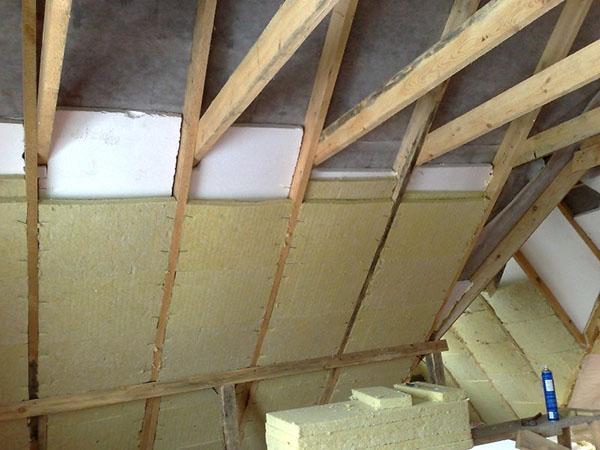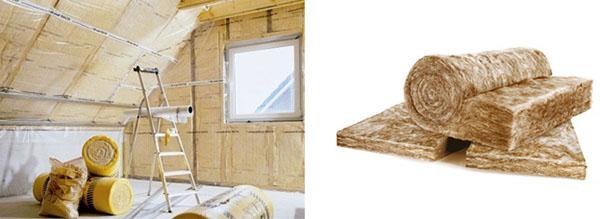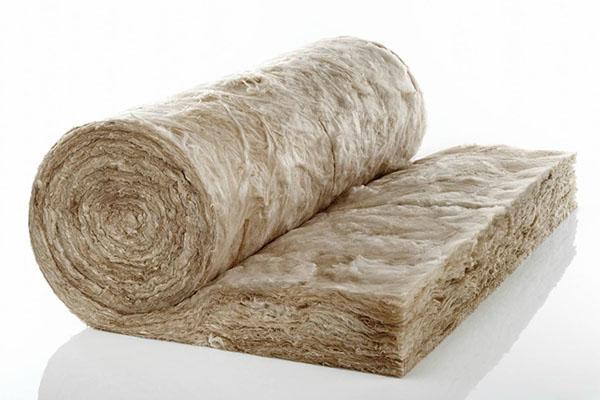What determines the quality insulation of the attic from the inside and outside
 Attic insulation is an economically viable solution that allows you to increase the usable area of the house and reduce overall heat loss. Insulating the floor, walls and roof of the attic reduces air humidity, which reduces the risk of mold.
Attic insulation is an economically viable solution that allows you to increase the usable area of the house and reduce overall heat loss. Insulating the floor, walls and roof of the attic reduces air humidity, which reduces the risk of mold.
Choice of materials
The most common materials for insulating a mansard roof include:
- Fiberglass is a budget option. The insulation is not subject to combustion, elastic, resistant to microorganisms and not attractive to rodents. The disadvantages of fiberglass include the danger of dust getting into the eyes and on the skin.

- Mineral wool is a heater with natural components, which is distinguished by fire safety, biological and chemical resistance, high vapor permeability and resistance to temperature extremes. When choosing how to insulate the attic from the inside, you should take a closer look at mineral wool - it is easier to lay, and the cost of the material is lower than that of analogues.

- Linen or cotton fabric insulation (ecowool). The light friable material is 81% recycled cellulose. Ecowool is mounted by spraying. The thermal conductivity coefficient of the material is 0.032… 0.041 W / m * K, which is comparable with the indicators of the best mineral insulation materials.

- Extruded polystyrene foam. It is waterproof, resistant to inorganic solvents, lightweight and thick, high deformation resistance.

- PPU (polyurethane foam). It is easy to apply on inclined surfaces. The consistency of the material resembles polyurethane foam. The liquid has a two-component composition with a hardener and a foamable base.

When choosing how to insulate a mansard roof, it is worth giving preference to a material with a lower thickness (when buying plates and rolls) and thermal conductivity. It is important to take into account the peculiarities of protecting the insulating layer from moisture and steam. The best options include extruded polystyrene foam and mineral wool.
Methods for insulating a mansard roof
 With complex insulation of the attic, it is important to take into account the sequence of work. First, the floor is insulated, then the walls (gables) and the roof.
With complex insulation of the attic, it is important to take into account the sequence of work. First, the floor is insulated, then the walls (gables) and the roof.
Floor insulation

The most effective way to insulate the attic floor is a dry screed. Sequence of work:
- Lay a layer of waterproofing on the floor.
- Pour in granular material and level with beacons.
- Lay fiber boards in 2 layers.
Laying classic wooden floors with mineral insulation to protect the voids is another effective way of insulating them.
Insulation of the attic walls
 The pediment is insulated in such a way that the areas most susceptible to condensation are carefully insulated. The dew point (the plane of formation of water from steam) should be shifted as far as possible towards the street.
The pediment is insulated in such a way that the areas most susceptible to condensation are carefully insulated. The dew point (the plane of formation of water from steam) should be shifted as far as possible towards the street.
The sequence of insulation of the attic walls:
- From the back of the racks of the future wall, fill in wooden slats at a distance of 30-40 cm from each other.
- Place the pre-cut insulation boards between the supports.
- Cover the entire surface of the wall with a vapor barrier film and hem with slats.
- Glue the membrane joints with tape.
 The finishing coating of the attic walls is made of fireproof and moisture-resistant plasterboard.
The finishing coating of the attic walls is made of fireproof and moisture-resistant plasterboard.
If it is necessary to carry out hidden communications, they are placed in insulation under the skin.
Roof insulation
 Insulation of the attic roof is the most difficult process in the entire scheme of insulation of the attic. The complexity of the work is due to the large number of beams. However, they allow you to securely fix boards or roll material.
Insulation of the attic roof is the most difficult process in the entire scheme of insulation of the attic. The complexity of the work is due to the large number of beams. However, they allow you to securely fix boards or roll material.
The sequence for insulating the attic roof from the inside:
- Install the waterproofing by gluing the edges of the film with construction tape. The membrane is fixed with a stapler on wooden elements.
- Create an air gap by installing the lathing. Insulation will rely on its elements. The slats should be located at a distance of 30-40 cm from each other.
- Lay the insulation between the logs. It is important to create a ventilation gap between the slabs and the vapor / waterproofing barrier. It provides air circulation between materials and has a beneficial effect on the indoor microclimate.
- Attach vapor barrier membrane.
- Create a lathing for the topcoat. Thinner insulation can then be applied to prevent heat leakage through the rafters.
- Carry out finishing cladding.
When insulating a broken attic roof, it is worth choosing a sprayed material. It is easier to apply, and joints and crevices will be reliably protected from the penetration of cold air.
The peculiarity of insulating the attic from the inside is that the waterproofing layer must have a complex configuration, bypass everything rafters and displayed under the roof for water drainage.
It is worth fixing the moisture-proof film with wooden slats - the surface of the membrane is disturbed less, and it keeps more neat.
The attic insulation scheme is shown in the photo below:
Insulation of the attic outside
 Often the attic is protected from the cold during the roof construction phase.
Often the attic is protected from the cold during the roof construction phase.
To figure out how to insulate the roof from the outside, it is worth finding out the order of work:
- From the side of the room, fill the crate - the planks should be located across the rafters. Instead of a frame, galvanized wire or cord is sometimes fixed.
- Lay the thermal insulation material on the batten from the side of the roof. At this stage, it is important to control the absence of gaps.

- Roll the diffusion membrane over the heat insulator with an overlap of 10-15 cm. The waterproofing is mounted in strips, moving from bottom to top.
- Fill the lathing and roofing.
- From the side of the room, fix and tape the vapor barrier film with tape.
- Carry out interior decoration.
With the external version of insulation, the material is easier to mount, since it is easier to lay it between the rafters.
What vapor barrier to choose for the attic
 As a vapor barrier, modern developers use various materials:
As a vapor barrier, modern developers use various materials:
- Polyethylene film. The material is laid in the process of creating a roof. A prerequisite for installation is the creation of ventilation gaps to prevent the formation of condensation. Evaporation of vapor particles occurs when laid with the rough side out.
- Polypropylene films. The material is highly durable. When choosing a vapor barrier of this type, it is worth additionally laying a layer of cellulose or viscose on the top side of the layer. This is necessary to absorb condensation drops.
- Reflective membranes. For such insulation, it is not required to create ventilation gaps - due to the special structure, the material allows air to pass through and retains moisture. The membrane has high reliability and quality.
The method of fixing the vapor barrier depends on the type of surface. To bricks, concrete or foam blocks, the material is attached to a double-sided tape. The membrane is fixed on wooden surfaces with a stapler or nails. It is important to install the vapor barrier with the smooth side into the room.
Major mistakes

Difficulties after warming the attic often arise due to the following errors:
- Insufficient insulation thickness.
- Poor insulation of hydro and vapor barrier joints.
- Installation of crumpled insulation. As a result of structural disruption, the material loses its operational properties.
- Lack of filing of eaves.In such cases, moisture freely penetrates into the insulation.
- Condensate drainage is not well thought out.
- Insufficient tension on the vapor barrier. When this layer sags, there is no gap between the film and the drywall, resulting in a deterioration in the finish. If you do not glue the joint between the vapor barrier and the wall with self-adhesive tape in time, the insulation will be filled with water and lose its properties.
In the process of insulating the roof of the attic, it is important to pay attention to the recommendations of specialists:
- When insulating the attic, it is important to take care of the thorough insulation of the windows.
- To ensure ventilation of the insulation, it is worth leaving a gap between it and the waterproofing of at least 2-3 cm.
- Do not skip any of the layers of waterproofing or vapor barrier.
- If the insulation is thicker than the rafters, their height is increased by stuffing additional slats.
When insulating the attic, it is worth approaching the work in a complex way - to protect the roof, walls and windows from the penetration of cold. It is important to choose the right insulating materials and how to install them, taking into account the characteristics of the building.
After reading the article, I decided to see how I did it (I live outside the city). Not. All is well, under the corrugated board there is an excellent layer of insulation, and on the floor of the attic too. He built the house himself together with the tower, and the brigade was a good one, I am still grateful to the foreman Alexei